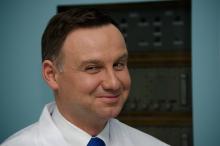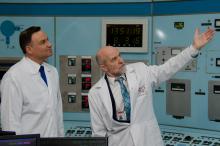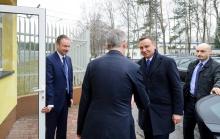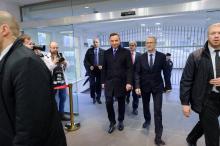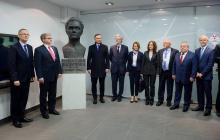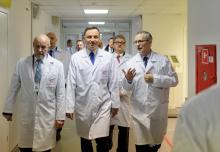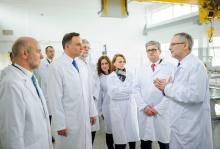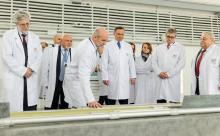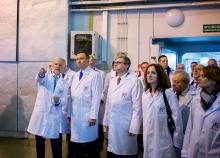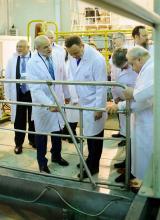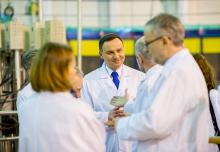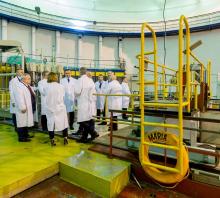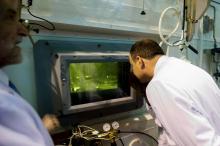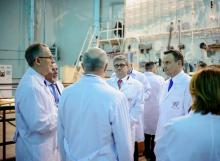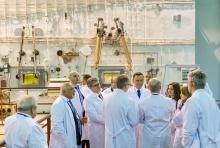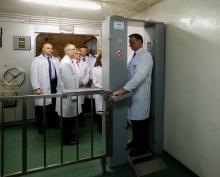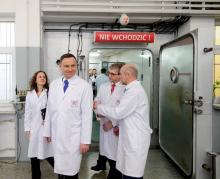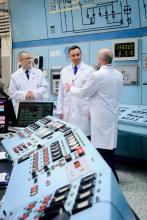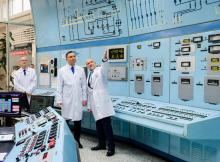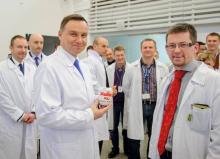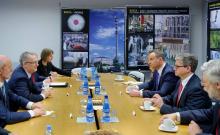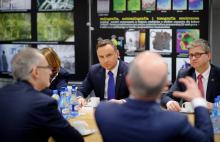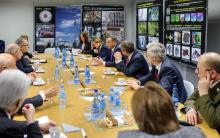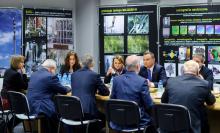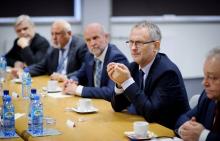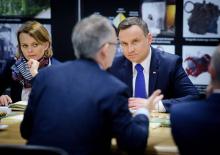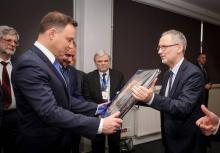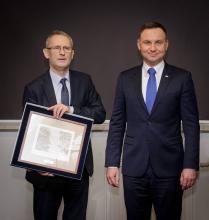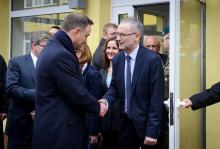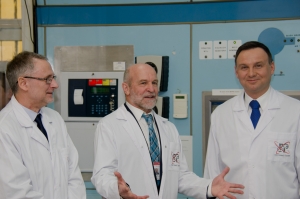
From left to right: Krzysztof Kurek, NCBJ Director General; Grzegorz Krzysztoszek, Director of NCBJ Nuclear Facilities Operations Department; Andrzej Duda, President of Poland (photo Marcin Jakubowski, NCBJ)
Andrzej Duda, President of Poland, visited MARIA, the sole nuclear reactor operated in Poland, where he was presented with outcomes of the already concluded MARIA’s fuel conversion process. Poland committed to switch the fuel from highly enriched uranium (HEU) to low-enriched uranium (LEU) back in 2004 when it joined the Global Threat Reduction Initiative (GTRI) programme.
Participants of the President’s visit included: Paweł Soloch, Head of National Security Bureau; Jadwiga Emilewicz, Deputy Minister of Development, Andrzej Piotrowski, Deputy Minister of Energy, Janusz Włodarski, President of National Atomic Agency; Krzysztof Kurek, NCBJ Director General, Andrzej Cholerzyński, Director of Radioactive Waste Disposal Enterprise, Grzegorz Krzysztoszek, Director of NCBJ Nuclear Facilities Operations Department.
"It must be pointed out that MARIA is currently an unquestioned hallmark of Poland” – said Professor Kurek, NCBJ Director General – "It is one of the most modern reactors of the kind in the world. Polish scientists and engineers have designed the reactor and for more than 40 years have been taking care of its safe operation. Their efforts helped Poland to fulfil its obligations under the GTRI programme. The successful completion of the HEU-to-LEU conversion project has confirmed a high level of competence of NCBJ staff in the field of nuclear reactor physics and nuclear power”.
The GTRI programme was launched by US government to reduce global exposition to terrorist attacks. Poland joined the programme in 2004 and committed to switch MARIA’s fuel from the then used HEU fuel elements (36% of uranium 235) to LEU elements (below 20% of uranium 235). Such a conversion is a rather complicated undertaking due to significant differences in physical parameters of both fuel types. Change of uranium enrichment level and modification (to some degree) of construction of fuel elements brought about change of some physical parameters of the reactor core (such as effective lifetime of neutrons, effective share of delayed neutrons, temperature coefficients of reactivity), which are essential from the reactor stability point of view. Therefore the conversion operation had to be preceded by some careful analyses and simulations. All computations were double-checked by both NCBJ and Argonne National Laboratory experts who used the same software codes. Practical tests of new LEU fuel elements produced in France commenced in 2009, gradual replacement of the fuel took less than two years to complete. To-day MARIA is running exclusively on LEU fuel. The first batch of LEU fuel was financed by US government. Contract for delivery of next batches was recently reached by NCBJ and TVEL, a Russian supplier of LEU fuel elements.
"Even if MARIA fuel conversion was a complicated operation, we have managed to keep reactor power at its previous level (30 MW) and to increase reactor uptime to 4,800 hours annually. That way our capacity to conduct research and to produce radioisotopes has expanded.”– added Professor Kurek – "Last year National Atomic Agency issued a license to operate MARIA for another 10 years. It is a good news for patients treated with nuclear medicine products. Since 2010 MARIA has irradiated uranium targets in amounts sufficient to produce the molibdenum-99 isotope for 75.5 million patients”
Research reactors (including Polish MARIA) have to operate continually because short-lived radioactive isotopes used in nuclear medicine cannot be produced for stock – fresh supplies are mandatory. For that reason UN is coordinating work of all research reactors in the world. In case one of them is temporarily down, others must take over the production. Last year it happened that reactor in Petten (the Netherlands) was temporarily shut down, and MARIA output was temporarily boosted to meet the demand. The number of uranium targets irradiated during just a single week of an extra intensive work of the Polish reactor was sufficient to produce nuclear medicine preparations for 100,000 patients. MARIA-irradiated materials are a starting point to produce not only molibdenum-99 (probably the most popular radiopharmaceutical), but also a number of other preparations exported under the POLATOM tradename to 80 countries all over the world.
To irradiate materials for production of radiopharmaceuticals and other isotopes for industry is by far not the only task of the MARIA reactor. First of all it is an intense source of neutrons, particles of extraordinarily valuable properties for physicists (flux on the order of 1014 neutrons/s*cm²). Electrically neutral neutrons easily interact with matter (not being repelled by Coulomb barriers around nuclei) by all four known force fields (strong, electromagnetic, weak, and gravitational); therefore they may be used as excellent probes of matter. Such R&D works with potential applications in medicine, economy, industry, archaeology and/or art history are conducted in Świerk on six horizontal channels through which beams of neutrons are exited from the reactor core. Some new research bays are planned, including the “Neutrons H2” bay to be used in studies employing epithermal neutrons. Polish scientists are going to join research on Boron Neutron Capture Therapy, an innovative method to cure e.g. brain tumours. An intense international cooperation helped to acquire 200 million Euro worth research equipment (spectrometers, diffractometers) from the recently decommissioned BER-II reactor in Berlin. Some agreements have already been signed and the first delivery of the equipment is expected within a few coming months. MARIA is also used as an instructional aid by instructors who train future nuclear physicists and/or radiation protection professionals. In their efforts to popularize nuclear-related topics across the society, staff of NCBJ Training and Education Division is hosting in Świerk more than 7,000 visitors each year (mostly excursions of high school students), who are very anxious to sightsee also the sole in Poland nuclear reactor.
History of nuclear research in Poland is more than 60 years long. In June 1955 governments of USA, UK and Soviet Union declassified nuclear-physics related topics and made nuclear technologies available to other countries. The first conference on peaceful applications of atomic energy held in Geneva gave green light to disseminate nuclear technologies, and soon afterwards the Institute for Nuclear Research was called into being in Świerk. Construction of EWA, research reactor offered by Soviet Union to most countries of the Soviet bloc (Poland, Bulgaria, Czechoslovakia, East Germany, Romania, Hungary) started three years later. Nuclear waste repository was simultaneously built next to EWA in Świerk, while nuclear waste disposal site – in an old military fort in Różan. EWA was operated for 3,500 hours annually until decommissioned on February 24, 1995. Between 1997 and 2002 all highly active substances were removed and the construction was dismantled. To-day the room previously occupied by EWA is used by Radioactive Waste Disposal Enterprise, NCBJ’s neighbour in Świerk.
The MARIA reactor entirely designed and constructed by Polish engineers and technicians was put in operation in Świerk in 1974. Its design of the channel/pool type is rather unusual. Fuel rods and other elements of the reactor core (beryllium moderator blocks, graphite reflector blocks, control rods, containers with the to-be-irradiated targets) are kept together by the so-called core basket placed under a 7-metres thick layer of water within the reactor pool. Another adjacent pool separated by a water lock plays the role of a short-term storage facility for spent fuel, irradiated constructional elements and materials. Core construction is modular, so that the core may be quickly, easily and safely adapted to changes in the research or production programme. MARIA is equipped with a number of safety-related facilities: cooling loops, ventilation systems, start-up/power-up interlocks, emergency core flooding system, multistage power supplies that guarantee uninterruptible power supply both in operational conditions and in emergencies, reactor waste processing systems, special radioactive waste management system, extended dosimetric system (continuous monitoring of radiation fields and radiologic exposition). It is estimated that MARIA will remain operational until 2060.
